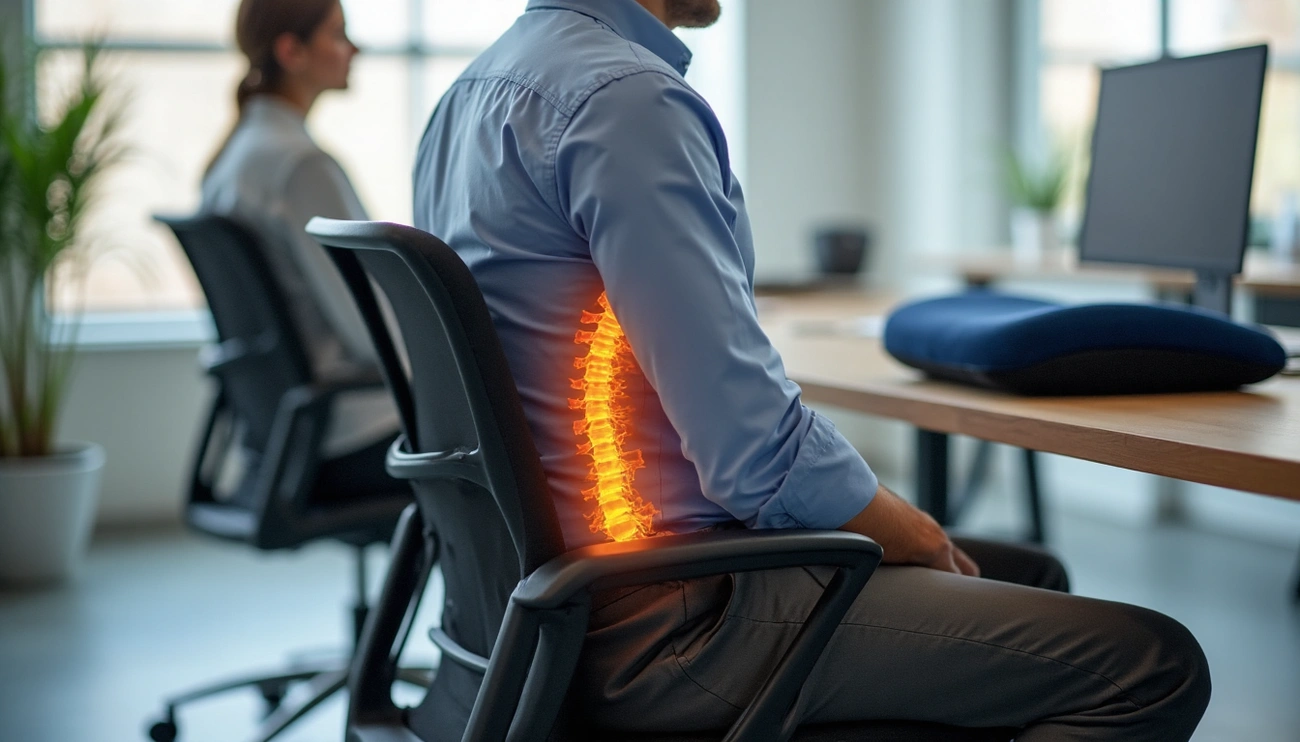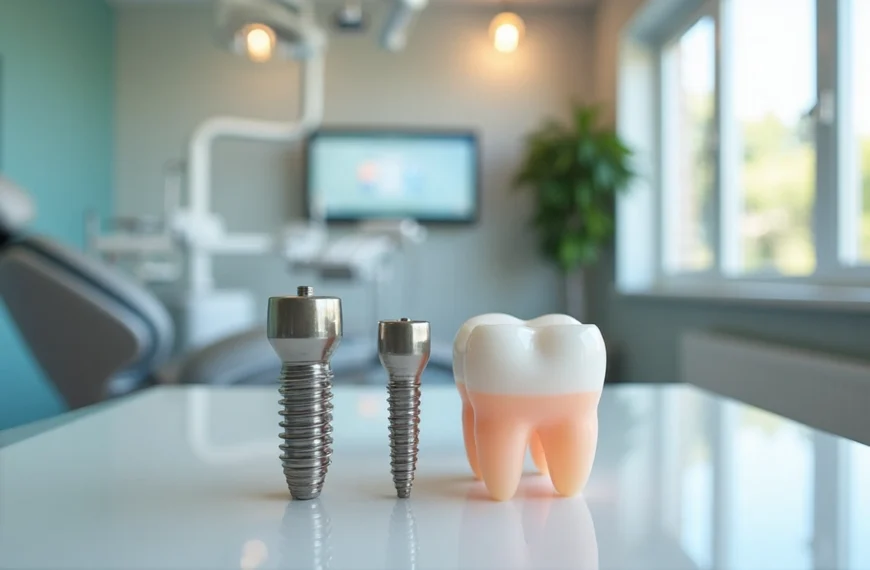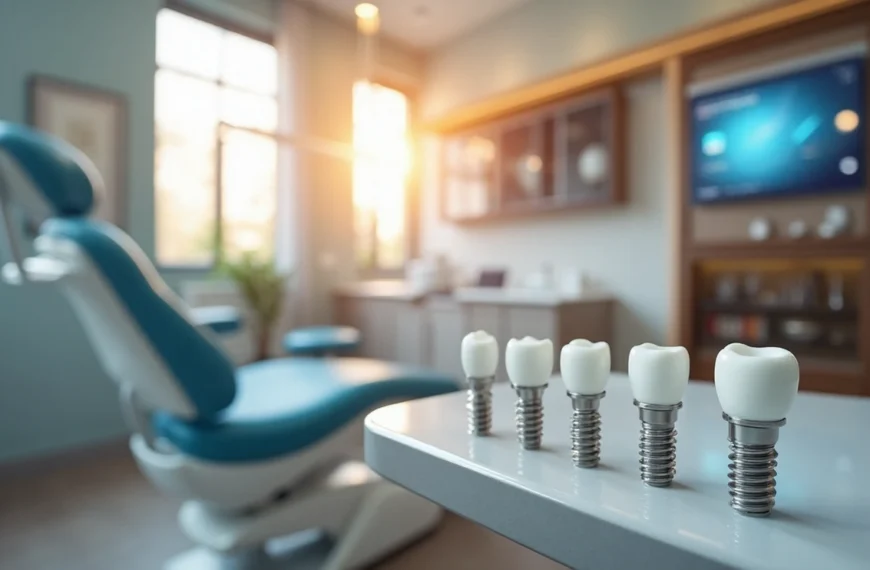Back pain plagues desk workers who spend extended hours in their office chairs. Research indicates that lumbar disk pressure rises approximately 30% during sitting versus standing. Poor posture and extended periods of slouching create additional stress on the lower back.
Standard office chairs typically lack adequate support for proper posture. A lumbar pillow can improve sitting posture and reduce lower back pain, which helps people maintain an active lifestyle. Ergonomic office chairs provide the best support. However, quality lumbar support accessories are affordable alternatives that help users with mild lower-back pain and posture issues. This piece examines the problems with conventional office chairs and presents practical, research-backed solutions to reduce back pain.
Why Your Office Chair Is Hurting Your Back
Your office chair’s connection to back pain runs deeper than just feeling uncomfortable. Research shows that nearly 39% of people develop serious pain in most body regions when they sit too long. This happens because chair makers didn’t consider how the human spine works when designing their products.
How poor posture develops over time
Long periods of sitting change how your body works. You might start with good posture, but fatigue kicks in after a few hours. Your spine-stabilizing muscles get weaker while others become tight, which creates imbalances. Your neck and back muscles slowly weaken. This leads to your head pushing forward and your spine forming a “C” shape instead of its healthy “S” curve.
Slouching at your desk puts about 30% more pressure on your lower back disks than standing does. It also makes your hip muscles tight while your stomach and buttock muscles become weak, which hurts your posture even more.
The hidden stress on your spine
Your lower back has a natural inward curve that gets stressed when you sit without good support. This wrong alignment puts extra pressure on your spinal disks and nearby structures. This can lead to disk damage and long-term pain. Studies show about 80% of adults deal with lower back pain at some point, and bad chairs often make it worse.
The SAID Principle (Specific Adaptation to Imposed Demand) shows how our bodies adapt to positions we keep for long periods. Sitting in a badly designed chair for 6-8 hours each day weakens your core, throws off your spine’s alignment, and increases pressure on your spinal disks.
Why standard chairs fail to support your back
Standard office chairs create several problems:
- Inadequate lumbar support: Regular chairs use back support that just pushes into your spine and sits too high to help your whole back
- Poor design fundamentals: Most chairs let you develop bad posture habits that hurt you over time
- Lack of adjustability: Chairs without proper adjustment options force you into awkward positions that strain your muscles
The biggest problem starts at your spine’s base. Regular chairs don’t position your sacrum and pelvis correctly, which affects your whole spine’s shape when you sit. This basic design flaw explains why many people’s backs hurt in office chairs, despite what chair companies claim about comfort.
Common Chair Features That Worsen Back Pain
Image Source: Meet&Co Office Furniture
Standard office chairs have several features that can cause back pain, even when manufacturers market them as comfortable. You can identify and fix what’s causing your discomfort by learning about these problematic elements.
Lack of lumbar support
Your spine’s lumbar region curves naturally inward and carries most of your body’s weight. The spine flattens in an unnatural way when you sit without proper support for this curve. Most non-ergonomic chairs lack adequate lumbar support. Your back muscles work harder to stay properly arranged, which leads to fatigue and strain. Your spine’s natural S-shape becomes compromised without good lumbar support, and this puts too much pressure on your lumbar disks and muscles.
Incorrect seat depth and height
A too-deep seat pushes against your legs’ back or makes you sit too far forward, which moves your pelvis out of proper position. Research shows the ideal seat cushion thickness should be 1.5 to 2 inches for comfortable long-term sitting. Your feet might dangle if your chair sits too high, which forces you to move forward and lose back support – OSHA labels this position as dangerous. Your chair sits too low if your knees rise above your hips, and this creates too much hip flexion.
Non-adjustable armrests and backrests
Users often lean sideways to rest one forearm when armrests don’t adjust properly. This creates uneven postures that tire out the neck, shoulders, and back. Regular backrests don’t have the right curve to keep your spine properly arranged. Non-ergonomic chairs usually lack customization options like adjustable seat height, armrests, and backrest tilt – features you need to fit different body types.
Overly soft or hard cushions
Soft cushions create problems because your body sinks in and blood can’t flow properly. You’ll struggle to sit correctly in chairs with rigid or very soft seats. Over time, foam cushions break down and leave you sitting on hard surfaces. Hard cushions can make nerve or joint problems worse.
Simple Fixes That Actually Work
Image Source: Autonomous
You don’t need an expensive new chair to ease back pain from sitting. These practical solutions can change your existing seating setup to make it more spine-friendly.
Use a lumbar pillow for chair support
Ergonomically designed lumbar cushions support the natural S-curve of your spine when regular chairs don’t measure up. These pillows naturally conform to your lower back and help you maintain proper neutral spine position. The best options come with removable, washable covers and adjustable straps that keep them firmly in place.
Try a seat cushion for back pain relief
Seat cushions are a great way to get back support without buying an expensive desk chair. The specialized coccyx cutouts provide tailbone relief while distributing your body weight evenly. Many spinal surgeons recommend these cushions to patients with back pain, joint problems, slipped disks, or sciatica.
Adjust your chair to fit your body
Good posture’s foundations start with proper chair adjustment. The seat height should let your feet rest flat on the floor while keeping knees at or slightly below hip level. Your chair’s backrest needs to support your lower back’s natural curve. The armrests should line up with your elbow height while your shoulders stay relaxed.
Switch to an office chair for back pain with ergonomic features
Ergonomic chairs support all four spinal regions: cervical, thoracic, lumbar, and sacrum. Look for chairs that have adjustable lumbar support which adapts to your unique shape. The best options accommodate the 53 posture changes people naturally make each hour.
Incorporate a footrest for better posture
Footrests add stability when your feet don’t reach the floor comfortably. They encourage “active sitting” through gentle rocking motions that boost blood flow and lower the risk of varicose veins. Your feet’s proper support lets you lean back fully into your chair’s backrest, which spreads pressure more evenly across your body.
Best Products to Support Your Spine
Image Source: Amazon.com
Specialized ergonomic products help treat office chair back pain. The right support can make a huge difference to your comfort and spine health throughout the day.
Best lumbar support for office chair
The Tempur-Pedic LumbarCushion Travel really shines with its special foam that keeps its shape after long-term use. This cushion’s 2-inch thickness gives your spine great support without pushing you too far forward. People who need more coverage should check out the Relax Support RS1 Pillow. It comes with adjustable straps that hold firmly to most chairs and covers a wider area of your back.
Top-rated pillow for lower back pain
Physical therapists love recommending the Original McKenzie Lumbar Roll because it helps keep your spine properly lined up. You can get this cylinder-shaped pillow in standard or firm options, and its single strap fits most chairs easily. Dr. Wu mentions that its inflatable version “works wonders on airplanes”.
Best office chair back pain cushions
The Cushion Lab’s Back Relief Lumbar Pillow has a clever butterfly shape that supports multiple back areas. Its special contoured design creates a spine groove that helps fix your posture and eases back pain naturally.
Recommended chair cushions for back pain
The Tempur-Pedic Seat Cushion helps you sit better than regular flat cushions. Many users say it’s “very firm, with stable support”. The Cushion Lab’s Pressure Relief Seat Cushion works great for people whose tailbone hurts from sitting too long.
Conclusion
Back pain from office chairs is a systemic problem that affects millions of desk workers. Poor support for the spine’s natural curves in conventional office chairs leads to increased disk pressure, muscle imbalances, and chronic discomfort. Of course, poor posture develops gradually and makes these problems worse. This ended up creating that problematic “C” shaped spine instead of the healthy “S” curve.
Simple solutions can make the biggest difference instead of accepting discomfort as part of office work. A quality lumbar pillow helps maintain proper spinal alignment. Specialized seat cushions help distribute weight evenly and relieve pressure on your tailbone. Your chair’s correct height, depth, and armrest positions reshape how your body interacts with your seating.
A fully ergonomic chair offers detailed benefits, but many budget-friendly alternatives work well for specific pain points. The products we covered – from the Tempur-Pedic LumbarCushion to specialized seat cushions – give targeted support based on what you need. Preventing back pain depends on both your seating environment and good posture habits.
Your spine supports you through countless work hours, so it needs proper support in return. Today’s small changes to your seating setup can prevent years of discomfort and long-term damage. Back pain from office chairs affects many workers, but now you have the knowledge and practical solutions to protect your spine and work comfortably.
Key Takeaways
Your office chair could be silently damaging your spine, but simple, affordable solutions can transform your workspace into a back-friendly environment that supports long-term spinal health.
Sitting increases spinal pressure by 30% – Poor posture from standard chairs creates harmful disk compression and muscle imbalances over time.
Add lumbar support immediately – A quality lumbar pillow maintains your spine’s natural S-curve and prevents the damaging C-shaped slouch.
Proper chair adjustment is free medicine – Set seat height so feet rest flat, knees at hip level, and armrests align with relaxed elbows.
Seat cushions provide targeted relief – Specialized cushions with coccyx cutouts distribute weight evenly and reduce tailbone pressure during long work sessions.
Small changes prevent big problems – Budget-friendly ergonomic accessories like footrests and back pillows can eliminate pain without expensive chair replacements.
The key insight: You don’t need to endure back pain as an inevitable part of desk work. These evidence-based solutions address the root causes of office chair discomfort, allowing you to work productively while protecting your spine for years to come.
FAQs
Q1. How does sitting in an office chair affect your back? Sitting in an office chair increases pressure on your lumbar disks by about 30% compared to standing. Prolonged sitting without proper support can lead to poor posture, muscle imbalances, and increased risk of back pain over time.
Q2. What features should I look for in an ergonomic office chair? Look for chairs with adjustable lumbar support, seat height, seat depth, armrests, and backrests. These features allow you to customize the chair to your body, promoting better posture and reducing strain on your back.
Q3. Can adding a lumbar pillow to my existing chair help with back pain? Yes, using a quality lumbar pillow can provide essential support to maintain proper spinal alignment. It helps preserve the natural S-curve of your spine, potentially alleviating lower back pain caused by inadequate chair support.
Q4. Are seat cushions effective for reducing back pain from sitting? Seat cushions can be very effective, especially those designed with coccyx cutouts. They help distribute body weight more evenly and reduce pressure on the tailbone, providing relief for people with back pain, joint issues, or sciatica.
Q5. How often should I adjust my sitting position to prevent back pain? Studies show that people naturally change their posture about 53 times per hour. It’s beneficial to make minor adjustments frequently and take short breaks to stand or stretch every 30-60 minutes to promote better circulation and reduce muscle fatigue.











![No Win No Fee Lawyers: The Hidden Truth About Settlement Cuts Legal representation through no win no fee lawyers gives clients a way to fight cases without paying anything upfront. Many clients don't know that these services take a big chunk of money after winning the case. Lawyers usually take 25% to 40% of what you win as their contingency fee. The amount lawyers take from settlements can add up fast. A $100,000 settlement means your attorney gets $30,000 if they charge a 30% fee after winning your case. Your solicitor's cut might be £10,000 from a £30,000 compensation award, based on your agreement percentage. This payment model stays pretty much the same for no win no fee lawyers in different places, though percentages can change. This piece breaks down what you need to know about contingency fee deals. You'll learn about standard fee ranges, extra costs beyond the basic fee, and times when this payment setup might not work in your favor. Smart clients should think over these money matters before signing up with a lawyer to make better choices about their legal help. What No-Win No-Fee Really Means Image Source: Express Legal Funding A no-win no-fee arrangement, also called a Conditional Fee Agreement, changes the way people get legal help. This payment approach removes the need to pay legal fees upfront and creates a partnership between clients and their attorneys. How contingency fees work No-win no-fee agreements are based on contingency fees. Lawyers get paid only when they win compensation for their clients. Most lawyers take between 25% and 40% of the final amount, based on how complex the case is and where it's filed. Lawyers take their cut after winning the case. To name just one example, see a case where a lawyer wins £30,000 in compensation with a 33% fee - they would receive £10,000. On top of that, some law firms use sliding scales where they charge less for quick settlements and more if the case goes to trial. The law requires a written agreement before any work starts. This paperwork spells out the lawyer's percentage, what costs you'll need to cover, and other key details. What happens if you lose the case The meaning behind "no-win no-fee" is clear - losing your case means you won't pay your lawyer anything. All the same, you should know about a few money-related details. You won't owe your lawyer when you lose, but some deals might make you pay for court fees, expert witnesses, or other case expenses. The other side could also ask you to pay their legal costs. Many lawyers suggest getting "After Event" insurance to protect their clients. These policies cover any costs if you lose your case, which makes the no-win no-fee setup much safer. Why lawyers offer this model Lawyers want to make legal help available to more people, so they offer these payment plans. This setup helps people who don't have much money take legal action when they have valid claims. The payment structure motivates lawyers to work hard. They only get paid by winning cases, which pushes them to get the best results possible. Lawyers carefully assess each case before taking it on a no-win no-fee basis. They usually accept cases that have a good chance of winning, since they put in lots of time and resources without any guaranteed payment. The Real Cost: How Much Do Lawyers Take from a Settlement Image Source: Greiner Law Corp. The true cost of no-win no-fee legal representation becomes clear once we look at contingency fees. Many clients feel surprised to see a big chunk of their settlement checks going to their attorney's fees. Typical percentage ranges (25%–40%) No win no fee lawyers typically ask for 25% to 40% of the total settlement amount. Personal injury attorneys usually take 33.3% (one-third) of the awarded compensation[101]. Lawyers and clients agree on this percentage before any work starts on the case. Several factors shape the final percentage. Your chances of winning, case complexity, and the work to be done play key roles in determining the attorney's cut. Some areas have laws that cap the maximum contingency fees for specific types of cases. Sliding scale based on case complexity Law firms often use a tiered fee system that changes with the case stage and complexity. This scale rewards quick settlements while paying attorneys fairly if more work becomes needed. The fee might start at 30% if the case settles before lawsuit filing. This number could climb to 35% after filing or reach 40% if the case goes to trial. Law firms often group cases by complexity: 10%-20%: Simple cases with straightforward settlements 25%-35%: Typical personal injury cases 35% and above: Complex cases requiring extensive resources Examples of payout breakdowns These ground examples show how fees affect settlements: A $15,000 settlement with a 33.3% contingency fee.pdf) puts $5,000 in the attorney's pocket, leaving $10,000 for the client. Similarly, from a $100,000 settlement with a 33% fee, the attorney gets $33,000 while the client receives $67,000[102]. Complex cases tell a different story. A $100,000 settlement with a 30% fee plus $5,000 in extra costs leaves $65,000 for the client after all deductions. These fees substantially change the client's final payout. Hidden Costs You Might Not Expect Image Source: Nelson Personal Injury Lawyers Beyond percentage-based fees, clients often feel surprised by extra costs that can reduce their final compensation by a lot. These hidden costs show up in the fine print of no-win no-fee agreements. You should think over these details before signing. Court filing and expert witness fees Legal proceedings come with unavoidable court filing fees. These charges differ by jurisdiction. They usually range from $30 for small claims to several hundred dollars for complex civil lawsuits. Expert witnesses can be expensive, with hourly rates ranging from $150 to $1,000 based on their credentials and testimony complexity. Expert witnesses charge more for court appearances than consultation work because of added pressure and prep time. Clients might still need to pay experts for their prep work even if the case settles before trial. Medical report and investigation costs Medical documentation is a vital part of many legal claims. These costs include fees to release medical records, create specialized reports, and prepare documents. Investigation costs cover evidence gathering, police reports, witness interviews, and other fact-finding work needed to build a strong case. Of course, some firms say they'll cover these expenses upfront, but clients don't completely avoid these costs. When these costs are deducted from your compensation Law firms take these expenses from the settlement amount before they calculate their percentage fee, though each firm handles this differently. Some lawyers subtract these costs after figuring out their contingency fee, which changes how much money clients end up with. Most firms pay case-related costs during the process and get their money back from the settlement. The defendant usually pays most simple legal costs and disbursements in successful cases, but not always everything. Insurance protects clients from costs in unsuccessful claims at many law firms, but this protection isn't guaranteed. Clients should review their agreements carefully since they might still need to pay specific expenses even if they lose their case. When No-Win No-Fee Might Not Be the Best Option Contingency fee arrangements give many people access to justice. However, this payment model doesn't always work in a client's best interests. Knowing these limitations helps clients make better decisions about their legal representation. Cases with unclear liability Lawyer no win no fee arrangements work best in cases where fault is clear. We assessed the probability of success before taking contingency cases. Lawyers might turn down cases if there isn't enough evidence of the other party's negligence or if liability isn't certain. Cases with multiple responsible parties create more challenges. The situation gets complicated fast when several parties share liability. Lawyers are less likely to take these cases on contingency. They need to be confident they can prove the other party's negligence before accepting a case. Low-damage or low-payout claims Small claims often don't work well with the contingency model, even with real injuries. Cases that have minimal injuries or limited financial damages might not bring enough compensation to cover legal costs. The potential settlement needs to be big enough to pay for investigations, witness interviews and court fees. Personal injury lawyers often turn down cases where the "compensation potential" is too small. This doesn't mean the claim isn't valid - it just means the economics don't add up for a contingency arrangement. Situations where hourly billing may be better Hourly billing has clear advantages in certain cases. Clients see exactly what they're paying for - every hour worked and task completed. This model works well for cases that need lots of attention but don't have clear financial outcomes. Complex litigation with opposing parties works better with hourly billing and a retainer fee. Clients have more control over their case and don't feel pressured to settle quickly. Cases that need extensive preparation but have uncertain outcomes fit the hourly model better. Lawyers can spend the time needed without worrying about contingency limits. This approach often leads to better representation, especially for complex legal issues that need special expertise. Conclusion Understanding the Full Picture Before You Sign No-win no-fee arrangements offer legal representation without upfront costs. Of course, this seems attractive at first glance. In spite of that, you need to think about how these agreements can affect your final compensation. Legal fees usually range from 25% to 40% of your settlement - but that's just the start. You'll face more deductions like court filing fees, expert witness costs, and charges for medical documentation. What looks like a "free" service ends up taking a big chunk of your compensation to cover legal expenses. These arrangements work best in specific situations - cases with obvious liability, substantial damages, and solid evidence. If you have a low-value claim or complex liability issues, traditional hourly billing might serve you better. Without doubt, you should ask for clear explanations of all possible costs before signing anything. Read the fine print closely, especially when you have to deal with expenses in unsuccessful cases. Ask to see sample settlement breakdowns that show all deductions. This helps you picture what you might actually take home. Your choice to go with a no-win no-fee arrangement depends on your situation. This model helps if you don't have money to pursue valid claims. But if you have a strong case and enough funds, other fee structures might let you keep more of your compensation. Whatever payment model you choose, knowing exactly how much lawyers take from settlements helps you make better decisions. This knowledge lets you approach legal representation with real expectations and better control over your money. FAQs Q1. What percentage of a settlement do no-win no-fee lawyers typically take? No-win no-fee lawyers typically charge between 25% to 40% of the final settlement amount as their contingency fee. The exact percentage often depends on the complexity of the case and the stage at which it is resolved. Q2. Are there any hidden costs in no-win no-fee arrangements? Yes, there can be additional costs beyond the lawyer's percentage fee. These may include court filing fees, expert witness costs, medical report expenses, and investigation costs. These expenses are usually deducted from the settlement amount before or after the lawyer's fee is calculated. Q3. What happens if I lose my case in a no-win no-fee arrangement? If you lose your case, you generally won't have to pay your lawyer's fees. However, you might still be responsible for certain expenses like court costs or the opposing party's legal fees. Many lawyers offer insurance to protect clients from these potential costs in case of an unsuccessful claim. Q4. When might a no-win no-fee arrangement not be the best option? No-win no-fee arrangements may not be ideal for cases with unclear liability, low-value claims, or complex legal issues requiring extensive preparation. In these situations, traditional hourly billing might be more appropriate and potentially more cost-effective for the client. Q5. Can I negotiate the percentage a lawyer takes from my settlement? Yes, the contingency fee percentage is often negotiable. It's typically agreed upon and formalized in writing before the lawyer begins working on your case. Don't hesitate to discuss the fee structure with your lawyer and ask for a detailed breakdown of potential costs and deductions.](https://consumersweek.com/wp-content/uploads/2025/06/No-Win-No-Fee-Lawyers-The-Hidden-Truth-About-Settlement-Cuts-870x570.webp)



